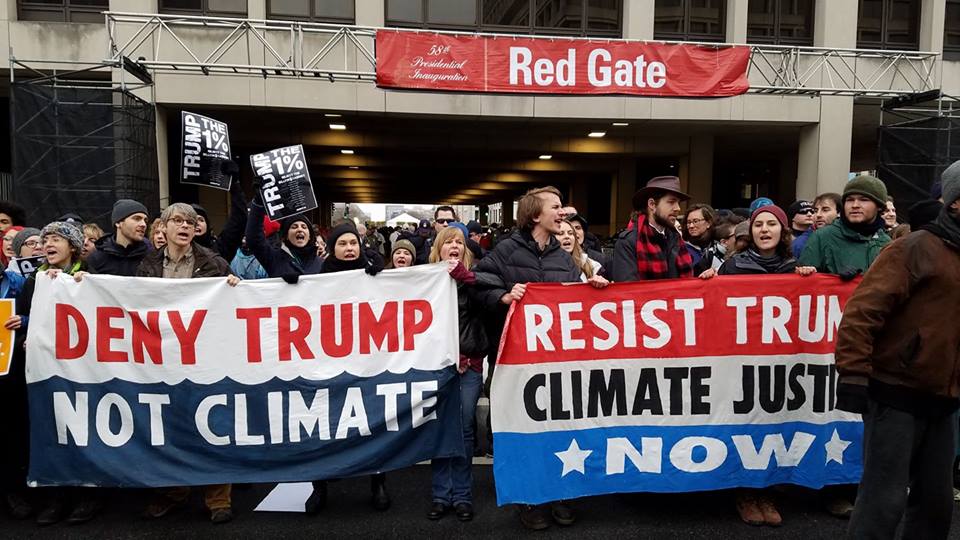In this post, Climate Disobedience Center Founders engage one another in conversation about our individual initial thoughts on post-election strategy. We have decided to have this conversation publicly and openly. We are not running our ideas or words by one another before we post them because we know that our best strategies emerge through conversation. We hope you will engage this conversation in the comments sections of the blog posts associated with this discussion. The original Thoughts on Post-Election Strategy post will serve as the table of contents for all posts related to this discussion. You can use it as a reference point to help you find other threads of the conversation.
Tim:
In Marla’s initial post, she rightly states, “But even when a high legal risk action doesn’t live up to that ideal, we need to find a way to support people who take non-violent disruptive action on behalf of us all.” That is certainly more true than ever, but I think we need to be ready for the spectrum of those actions to shift during a Trump regime. As other means of stopping destructive projects become less effective under strongman rule, it’s almost certain that more folks will turn to sabotage and monkey wrenching to stop fossil fuel projects. I have long argued that open civil disobedience is more effective than monkey wrenching in which we run away and let our opponents tell the story, but those arguments will ring hollow when even massive and sustained civil disobedience campaigns are not only ineffective but met with even greater state violence than we’ve seen at Standing Rock. This is not about what we want people to do. It would be naive to think that folks won’t turn to sabotage in their desperation. People are not simply going to give up on defending their future, and they are not going to indefinitely keep doing things that don’t work (unless they work for an NGO.)
So I think it is incumbent upon those of us with a public voice in this movement to be able to articulate how those acts of sabotage can be acts of love in defense of humanity and all life. We can’t afford to disown saboteurs in the hopes of maintaining our own respectability. We need to remind the public of the words of John F. Kennedy: “Those who make peaceful resistance impossible make violent revolution inevitable.” We have to help connect the dots between the lack of truly democratic structures, the violence against peaceful protestors like we just saw against our friend Sophia, the repression of dissent that we will see under a Trump regime, and the acts of sabotage that folks who care about people and planet take in desperation. Given how bad our society generally is at connecting dots, we’d better start soon. I believe that destroying a drill rig can be an act of love, but it will take some work to tell that story.
Jay:
Just in the few sort weeks since we began writing these pieces, I’ve been having more conversations with people who have perched themselves on the edge of activism for a long time (lulled into complacency by the Obama administration?), and who are now looking to take a deeper plunge. They are ready for a different kind of analysis. I think we have the opportunity to offer a different kind of analysis, and hope very much that we don’t shy away from a deeply subversive and paradigm changing view of climate disobedience. We founded the Climate Disobedience Center in part because of a shared critique of mass action that lacked moral punch. While mass action may become increasingly important in the coming years, I think it is critical that we continue to tell the story of impending climate cataclysm by earnest efforts of moral acts of nonviolent imagination.
A thread running through both Tim’s first piece and his response to Marla’s original piece seems to be the idea that civil disobedience actions – of the kind that the Climate Disobedience Center was founded to promote – are themselves designed to “slow the development of fossil fuels”. While that may be an important argument to make, and be very much the stated justification of our actions, that we have no other choice but to put ourselves in the way of this impending catastrophe, it is by no means the only reason why we do and should continue to do so.
The rationale for the “specific strategy of arousing the conscience of the community through spirit-centered civil disobedience actions” that we launched the Climate Disobedience Center with was indeed, as Tim says, based on “the fundamental notion that the authority of the government depends on the consent of the governed”. Tim then calls this assumption into question. I don’t know that I buy it.
I first encountered and took the ideas of nonviolent noncompliance seriously in college when I read Vaclav Havel’s “The Power of the Powerless”. Havel was of course writing in eastern Europe while under the thumb of the USSR. The notion that the client government of Czechoslovakia was functionally responsive to the consent of the government on it’s face seemed completely bonkers. Same was true of India under British rule. Havel’s contention, however, was that in fact even under a monarchy, it’s fundamentally true. And even that the “functional” consent of the government that was apparent in the West at the time operated under the same “powerless” dynamics as the Eastern Bloc.
The thing is that there is going to be enormous pressure in a more-oppressive regime for those pushing for change to be satisfied with holding the line and to take mass citron that doesn’t risk much. Yet it is precisely these individual acts of “living in the truth” as Havel puts it, that are required to arouse the population to move the dynamic that underlies whatever government may appear to be in power. I believe we are significantly mistaken if we believe that a broad popular front movement can be aroused without this sort of action. I don’t think we can create a sufficiently powerful “safe” protest space for mass engagement without upping the expectation that individuals will have to take risk.
The governor of North Dakota declared a state of emergency, and under this new administration we could be seeing similar types of repression against activists (as we recently saw a new bill to do so proposed in Washington State). This, however, is not a reason to change strategy, rather the opposite. I’m convinced one of the things that made the prayer camp at Standing Rock so visible and powerful was that it was repressed. It was the very repression that put it on the map, on the TV news, and into peoples hearts: that people are willing to suffer the tear gas, the rubber bullets, and the freezing cold water because something is so important. It is this powerful flow – of conviction lived concretely into the world – that empowers movements, specially movements grounded in the deep non-violence counseled by the elders of the Oceti Sakowin. It becomes powerful in the hearts and minds of others because it umasks the otherwise unseen reality: that it is possible to live without fear of reprisal, and that by doing so and disobeying (whether that is the law or the societal norms like leaving the little red book on the coffee table) we hold on to the one thing that fundamentally cannot be taken from us, our agency, and we birth freedom into the world.
Before this fall, my interpretation of Havel had been that the forces for change has numbed themselves into believing that they were powerless – mostly by ascribing agency to only professional change makers, lobbyists etc. or by thinking that the problem was too big, or that Washington was broken (yes, it is!) or some other external factor. Many good liberals believed that with President Obama’s Clean Power Plan, vehicle emissions standards, and the approval of the Paris Climate accords, that in fact we are doing something serious about climate. And we know that isn’t true. Well intentioned (maybe), but wholly insufficient.
However, the reality is that our powerlessness comes not from external factors (presidential administrations included) but from our own personal and inward relationship to our own power (or God’s power, if that is language that works for you). And that hasn’t changed since the election. Before the election we had an administration at the national level which talked a good talk on climate but did not achieve what was necessary. They soothed the public with nice words, and we kept on increasing our emissions. This is reminiscent for me of what Dr. King describes in “Letter from a Birmingham Jail” as the problem of the white moderate. The white moderate, not the climate deniers, are the real barrier to accomplishing our goals.
We have yet to create a sufficient sense of crisis in the public imagination that can force reasonable climate mitigation into the urgently felt priorities of the polity. I continue to be convinced like Havel, that embodying the truth in one’s life is the route of the powerless to shift the sands underneath whoever claims to be “in power”. The goal of climate disobedience continues is still to create such a sense of crisis and urgency that we break through that numbness. The danger now is not the same sort of complacency, believing that the administration in power has our best interests in mind, but in shirking away from boldness out of fear of retribution. It may be that precisely because of retribution, like that which happened at Standing Rock this fall, that the consciousness of the nation is aroused. It is not a guarantee, but I can’t see another mechanism for action.
May I be so bold and fearless in this future.
I’ll leave this with what I think is the essence of Havel’s argument. What do you think?
“It seems that the primary breeding ground for what might, in the widest possible sense of the word, be understood as an opposition in the post-totalitarian system is living within the truth. The confrontation between these opposition forces and the powers that be, of course, will obviously take a form essentially different from that typical of an open society or a classical dictatorship. Initially, this confrontation does not take place on the level of real, institutionalized, quantifiable power which relies on the various instruments of power, but on a different level altogether: the level of human consciousness and conscience, the existential level. The effective range of this special power cannot be measured in terms of disciples, voters, or soldiers, because it lies spread out in the fifth column of social consciousness, in the hidden aims of life, in human beings’ repressed longing for dignity and fundamental rights, for the realization of their real social and political interests. Its power, therefore, does not reside in the strength of definable political or social groups, but chiefly in the strength of a potential, which is hidden throughout the whole of society, including the official power structures of that society. Therefore this power does not rely on soldiers of its own, but on the soldiers of the enemy as it were—that is to say, on everyone who is living within the lie and who may be struck at any moment (in theory, at least) by the force of truth (or who, out of an instinctive desire to protect their position, may at least adapt to that force). It is a bacteriological weapon, so to speak, utilized when conditions are ripe by a single civilian to disarm an entire division. This power does not participate in any direct struggle for power; rather, it makes its influence felt in the obscure arena of being itself. The hidden movements it gives rise to there, however, can issue forth (when, where, under what circumstances, and to what extent are difficult to predict) in something visible: a real political act or event, a social movement, a sudden explosion of civil unrest, a sharp conflict inside an apparently monolithic power structure, or simply an irrepressible transformation in the social and intellectual climate.” – Vaclav Havel, “The Power of the Powerless”







Leave a Reply